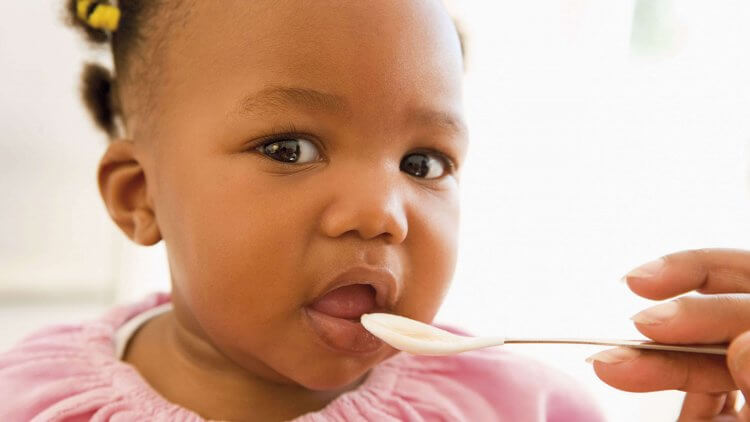Disclaimer [ENGLISH]
Disclaimer: This material is for educational purposes only. You, the reader, assume full responsibility for how you choose to use it. It is not intended to provide medical advice, diagnosis or treatment, nor does it replace the advice or counsel of a doctor or health care professional. Reference to a specific commercial product or service does not imply endorsement or recommendation of that product or service by CPCMG.

Most babies are ready for solids around 6 months old. Look for these signs:
- Your baby can sit up mostly on their own.
- Your baby can hold their head up for a long time.
- Your baby is interested in mealtimes and may grab food off your plate.
How to start solids:
- Introducing a variety of flavors, textures and colors when starting solid foods helps a growing child to be a healthier and more adventurous eater later, even during the picky eating phase that usually occurs between 18 to 24 months old.
- Start with foods that are great sources of iron and zinc for healthy brain development. These include:
- Iron- and zinc-fortified infant cereals
- Avocados
- Cooked legumes such as beans, peas, lentils

- Just give one new food at a time.
- Wait at least one to three days before introducing new foods so that you can tell if a baby has an allergic-type reaction such as a rash, vomiting or diarrhea in response to any specific food.
- To help prevent food allergies, offer foods like peanuts (in the form of peanut butter and eggs by the age of 6 months old.
- Eggs, peanuts, tree nuts, milk, soy, wheat, sesame, fish, and shellfish are the foods most likely to cause an allergic reaction. It has been shown that early introduction of peanut and egg specifically can prevent food allergies. See the Food Allergy Prevention article for more information.
- Offer fruits and vegetables at every meal, and snack time too! Avocado, bananas, sweet potatoes and squash are also excellent first foods.
How to feed:
- Traditionally, infants start with purees.
- Make sure the food is soft and small enough that your baby will not choke.
- It may take a baby a few tries to learn how to move the food to the back of the mouth to swallow.
- Start with thinner consistency and then gradually thicken the texture.
- Finger foods can usually be introduced around 9 to 10 months of age.
- Baby-led weaning is another method of introducing solid foods. For more information, Solid Starts, has several good free resources.
Important tips:
- Do not give honey until after 12 months old (due to a risk of an infection called botulism that can be very dangerous).
- Do not give choking hazards such as whole grapes, whole or partial nuts, popcorn, hot dogs/chunks of meat, hard raw fruits or vegetables, or sticky foods (such as nut butters that have not been thinned out with liquid).
- Foods can be made at home or store-bought. Avoid giving processed foods or those with high salt content.
- It can take many tries (8-12 or more!) to develop a taste for a new food, so keep trying even if your baby doesn’t like it the first time.
- Remember, you only need to offer a small bite or taste each time.
- You can decide what food is offered, when, and where, but let your child decide what to eat and how much.
Choose healthy drinks:
- Keep giving your baby breast milk until age 2 or as long as desired by infant and mother. Formula-fed infants should transition to whole or 2% milk at 12 months old.
- Offer water with meals. At 6 months old, you can start offering water from an open cup. This helps your baby get used to and prefer the taste of plain water while also helping to develop fine motor skills of getting the cup to their mouth.
- Do not offer juice or sweetened drinks, which can be very sugary and are unhealthy for your child's teeth.
- Avoid toddler formulas, unless otherwise directed by your child’s primary care provider.
- Do not put cereal in your baby’s bottle unless directed by your child’s primary care provider.
Watch for hunger and fullness cues:
- When starting solids, your baby is developing important eating skills including understanding and trusting their own hunger and fullness cues.
- If your baby turns their head away from food or keeps their lips shut, they are done eating. Don’t force them to eat more. It is normal for babies to only eat 1 or 2 teaspoons of food at a time when first starting solids. Over time they will begin eating more at each meal.
- As your baby begins to eat more solids, they will naturally start to decrease liquid intake from breast milk or formula.
- Include baby in family meals from the first feeding.
- Eating meals as a family is good for a child’s health and development.
You can find more information here:
Reviewed by: CY M.D., TT D.O. | 09/2024


